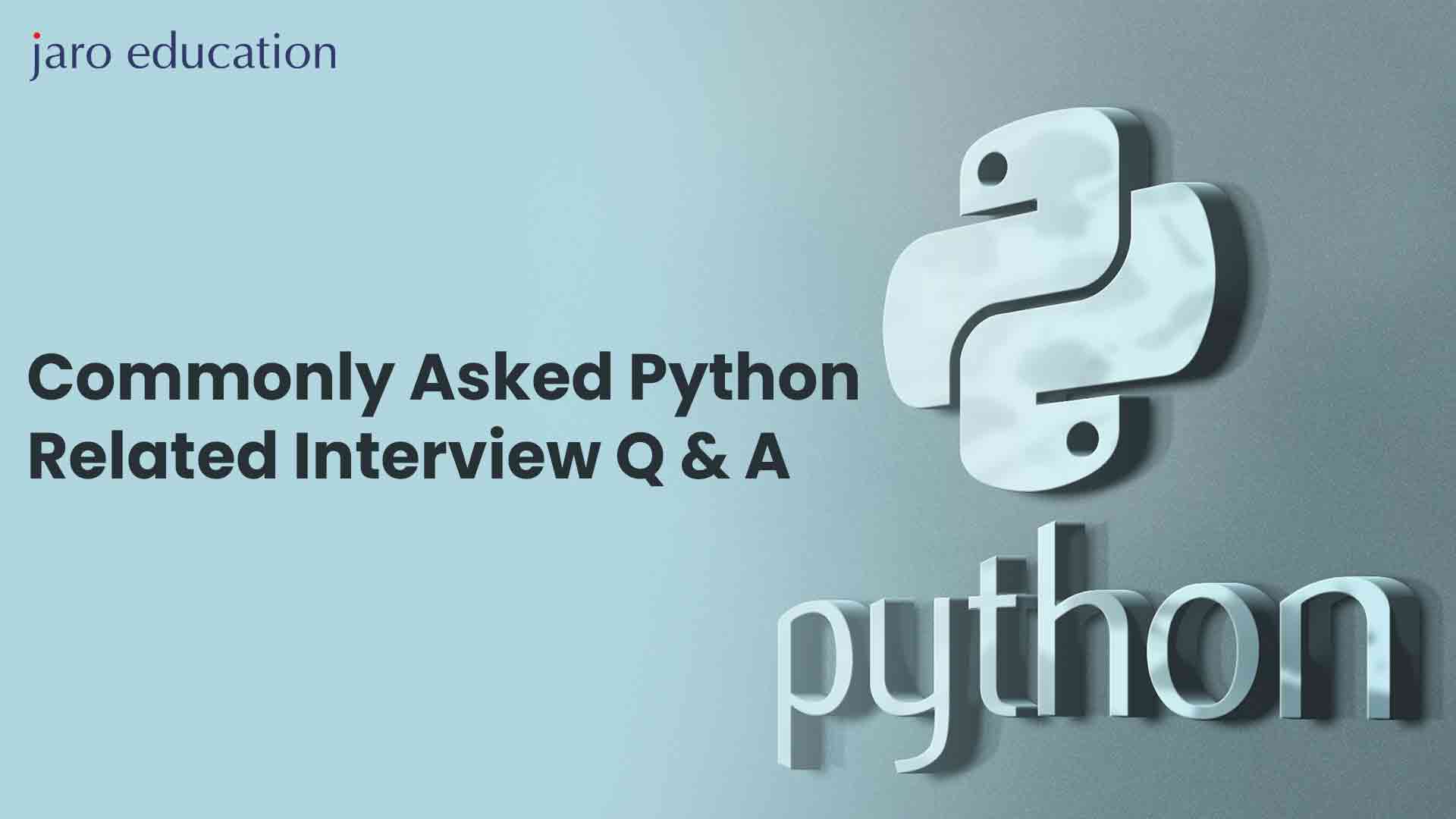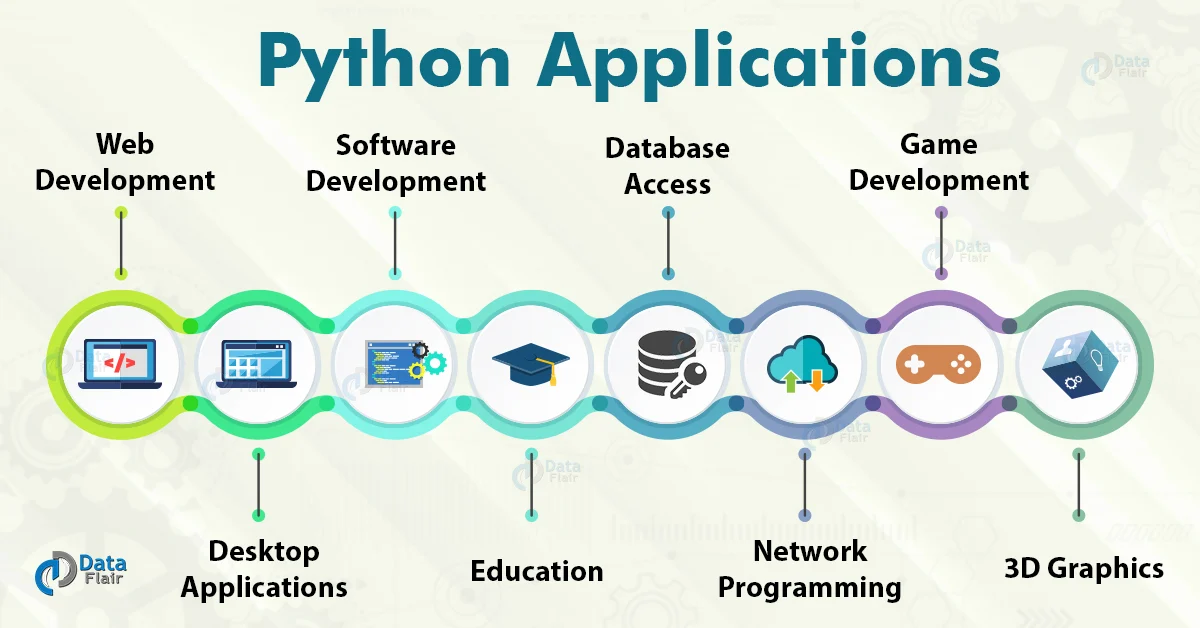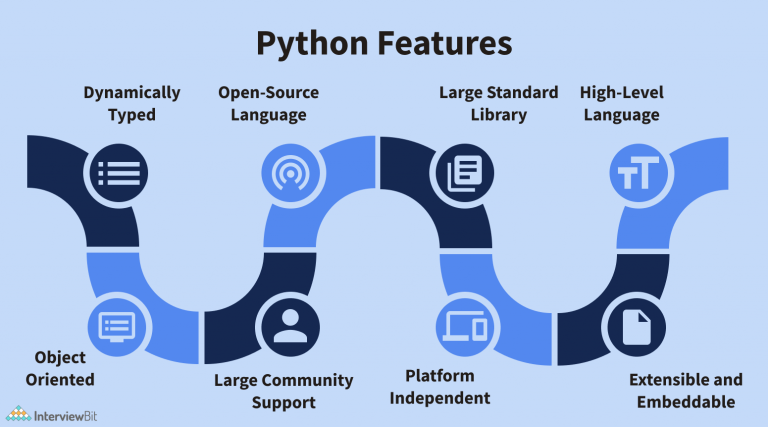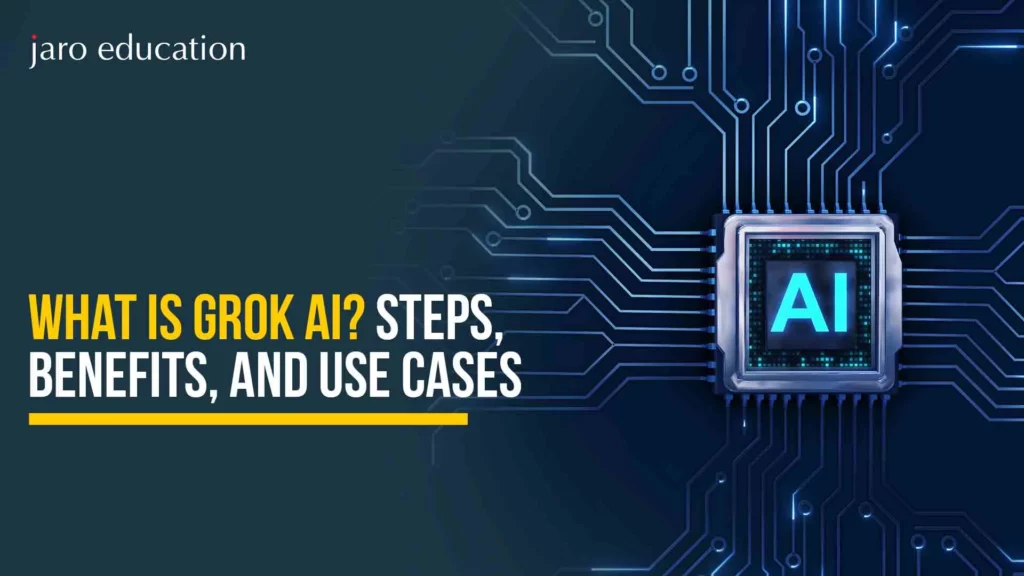Commonly Asked Python-Related Interview Questions & Answers
Table of Contents

- jaro education
- 21, January 2024
- 1:00 pm
In the fast-evolving landscape of software development and data-driven technologies, Python has emerged as a ubiquitous programming language. It offers a robust, versatile, and developer-friendly environment, making it a top choice for industries spanning web development, data science, artificial intelligence, and more. Consequently, Python-related interview questions have become a standard component of technical job interviews, across both entry-level and experienced positions.
This guide is designed to be your comprehensive resource for tackling Python interview questions and providing in-depth answers. Whether you are a seasoned Python developer looking to explore new career opportunities or someone just embarking on their Python journey, understanding these common interview questions and their solutions is crucial for your success.
Our exploration of Python interview questions covers a wide spectrum of topics. Let’s begin with fundamental Python concepts to ensure you have a solid foundation, and then progress to more complex and nuanced areas of the language. This diverse range of questions will equip you with the knowledge and confidence you need to excel in Python interviews. This resource will be your guiding light through Python interview Q&A’s. It will not only familiarise you with the types of questions you might encounter during your job search but also empower you with the insights and knowledge necessary to gain a competitive edge in today’s job market. Let’s dive into the world of Python interview questions and answers and arm you with the skills to shine in your technical interviews.
What are the Common Python-Related Interview Questions and Answers?
Explain the differences between Python 2 and Python 3.
Python 2 is an older version with legacy support, while Python 3 is the latest and has significant changes, including print statements, division, and Unicode handling. Python 3 is the recommended version for new projects.
3. What is the Global Interpreter Lock (GIL), and how does it impact Python programs?
GIL is a mutex that allows only one thread to execute in CPython (Python’s reference implementation) at a time. It affects multi-threaded Python programs, making CPU-bound tasks less efficient but does not impact I/O-bound tasks significantly.
4. Explain the difference between a list and a tuple in Python.
Lists are mutable (can be modified), while tuples are immutable (cannot be changed). Lists are defined with square brackets, and tuples with parentheses.
5. What is a Python decorator, and how is it used?
A decorator is a function that modifies the behavior of another function. It is often used to add functionality to functions or methods, like logging or authentication checks.
6. How does Python's garbage collection work?
Python uses automatic memory management and employs a reference counting mechanism to reclaim memory occupied by objects that are no longer referenced. Cyclic Garbage Collection is used to handle circular references.
7. Explain the purpose of virtual environments in Python.
Virtual environments are isolated environments that allow you to install and manage dependencies for your Python projects separately. They help avoid conflicts between project-specific libraries.
Explore Popular Blogs on Computer Application
15 Skills To Advance Your Career in MCA Get Ahead in Your Career with Online MCA Programme Understand 3 Crucial Areas of Development in Fundamentals of Computer
8. What are Python's built-in data types for numbers?
Python supports int (integers), float (floating-point numbers), and complex (complex numbers) as its primary numeric data types.
9. How do you open and read a file in Python?
You can open a file using the open() function and read its contents using methods like read(), readline(), or by iterating over lines using a for loop.
10. What is the purpose of the if __name__ == "__main__": statement in Python scripts?
This statement ensures that a block of code only runs when the Python script is executed as the main program, not when it’s imported as a module.
What is Python?
Python is a high-level, interpreted, object-oriented language with dynamic semantics. Its dynamic typing and dynamic binding, along with its high-level built-in data structures, make it an appealing language for Rapid Application Development and for usage as a scripting or glue language to join existing components. Because of its straightforward, basic syntax, Python emphasises readability, which lowers programme maintenance costs. Python’s support for packages and modules promotes code reuse and programme modularity. The large standard library and the Python interpreter are freely distributable and accessible for free on all major platforms in source or binary form.
Python’s increased efficiency is one of the main reasons programmers fell in love with it. The edit, test, and debug cycle is extremely quick because there is no compilation step. Python programme debugging is simple because segmentation faults are never caused by bugs or incorrect input. Rather, the interpreter raises an exception when it finds a mistake. The interpreter prints a stack trace if the programme fails to catch the error. Setting breakpoints, evaluating arbitrary expressions, inspecting local and global variables, stepping through the code one line at a time, and other features are all possible with a source-level debugger. The fact that the debugger is developed in Python attests to the language’s capacity for introspection. However, adding a few print statements to a programme is frequently the fastest method to debug it.
Why Python?
The global job market is currently experiencing a significant surge in demand for Python programming expertise, and this is primarily due to the compelling advantages that Python offers. Python has established itself as one of the leading programming languages worldwide and is on the verge of potentially claiming the title of the most popular programming language, as indicated by ZDNet. The PYPL Index, a reputable source for tracking programming language popularity, further reinforces Python’s prominence by ranking it as the most widely used programming language globally. This remarkable popularity has global implications, making Python a valuable asset for individuals seeking employment opportunities abroad, such as in Switzerland or Australia.
The beauty of acquiring Python skills lies in the fact that it opens doors to employment possibilities in diverse regions around the world. Whether you aspire to work in a different country or simply explore new professional horizons, Python can serve as your passport to a wealth of opportunities. This versatile programming language is not confined by geographical boundaries, making it universally relevant and in high demand in various industries and sectors.
In summary, the surge in Python’s popularity in the global job market is a testament to its versatility and applicability across borders. Whether you have your sights set on working abroad or wish to enhance your career prospects locally, mastering Python is a strategic move that can lead to exciting job prospects and professional growth in diverse regions.
How to Install Python?
Python is a versatile and powerful programming language widely used in various fields, from web development and data analysis to artificial intelligence. If you’re eager to start your Python journey, the first step is to install Python on your computer. This step-by-step guide will walk you through the installation process, whether you’re using Windows, macOS, or Linux. Let’s get started!
Step 1: Checking Your Current Python Version (Optional)
Before you begin the installation process, it’s a good idea to check if Python is already installed on your system and what version it is.
Step 2: Downloading Python
Visit the official Python website at python.org. You will find download links for various operating systems, including Windows, macOS, and Linux.
Step 3: Choosing the Python Version
Python offers two major versions, Python 2 and Python 3. It’s essential to choose Python 3, as Python 2 is no longer supported. At the time of writing, Python 3.9 is the latest stable version. Click on the download link for the version you prefer.
Step 4: Starting the Installation (Windows)
For Windows users, download the Windows installer executable (.exe) corresponding to your system (32-bit or 64-bit).
Step 4: Starting the Installation (macOS)
For macOS users, download the macOS installer.
Step 4: Starting the Installation (Linux)
For Linux users, you can typically install Python using your package manager, but it may not be the latest version.
Step 5: Configuring the Installation (Optional)
During the installation process, you’ll be presented with various configuration options, such as adding Python to your system’s PATH variable. It’s a good practice to enable the “Add Python to PATH” option.
Step 6: Verifying the Installation
Once the installation is complete, open a terminal or command prompt and check the Python version using the command “python –version.” You should also test the Python shell by entering “python.”
After this step you will have successfully installed Python on your computer. Now you’re ready to embark on your Python programming journey and explore the world of coding, data analysis, web development, and more.
What are the Applications of Python?

*data-flair.training.com
Web and Internet Development
Python provides a plethora of choices for web development, including well-known frameworks like Django and Pyramid, micro-frameworks such as Flask and Bottle, and advanced content management systems like Plone and django CMS.
Python’s standard library supports a wide range of Internet protocols, from HTML and XML to JSON and E-mail processing. It also offers support for FTP, IMAP, and various other Internet-related tasks with an easy-to-use socket interface.
The Python Package Index (PyPI) offers a wealth of additional libraries for web development, including Requests for HTTP client functionality, Beautiful Soup for HTML parsing, Feedparser for handling RSS/Atom feeds, Paramiko for implementing the SSH2 protocol, and Twisted Python for asynchronous network programming.
Scientific and Numeric Computing
Python is extensively used in scientific and numeric computing. Libraries like SciPy are collections of packages designed for mathematics, science, and engineering tasks. Pandas is a powerful library for data analysis and modelling, while IPython provides an interactive shell with features for editing, recording work sessions, and support for visualisations and parallel computing.
- The Software Carpentry Course is a valuable resource for teaching basic skills in scientific computing and offers open-access teaching materials.
- Python stands out as an excellent language for teaching programming, catering to both introductory and advanced courses. It has educational resources like “How to Think Like a Computer Scientist,” “Python Programming: An Introduction to Computer Science,” and “Practical Programming.”
- The Education Special Interest Group serves as a platform for discussing teaching-related issues.
Desktop GUIs
- Python’s standard library includes the Tk GUI library, which is bundled with most Python distributions. Various cross-platform toolkits, such as wxWidgets, Kivy (for multitouch applications), and Qt via pyqt or pyside, are available for developing graphical user interfaces (GUIs).
- Platform-specific toolkits like GTK+ and Microsoft Foundation Classes (through win32 extensions) are also options for GUI development.
Software Development
- Python is frequently employed as a support language in software development for tasks like build control and management, testing, and more.
- Tools like SCons are used for build control, while Buildbot and Apache Gump assist in automated continuous compilation and testing.
- Bug tracking and project management can be facilitated with tools like Roundup or Trac.
Business Applications
Python is used in building enterprise resource planning (ERP) and e-commerce systems. Examples include Odoo, an all-in-one management software suite, and Tryton, a high-level general-purpose application platform.
In summary, Python’s versatility and extensive library support make it a key player across a wide range of applications, from web development and scientific computing to education and business solutions. Its adaptability and extensive community support have cemented its place in the world of technology and beyond.
What are the Advantages of Python?
Python’s versatile applications are a direct result of its unique combination of features, setting it apart from other programming languages. Some of the advantages of using Python include:
Abundance of Third-Party Modules:
The Python Package Index (PyPI) boasts an extensive collection of third-party modules, enabling Python to seamlessly interact with a multitude of other languages and platforms.
Comprehensive Support Libraries
Python offers an expansive standard library that encompasses various domains, including internet protocols, string manipulation, web services tools, and operating system interfaces. Many common programming tasks have already been pre-scripted in the standard library, reducing the amount of code that developers need to write significantly.
Open Source and Community-Driven Development:
Python is developed under an open-source license approved by the Open Source Initiative (OSI), which means it’s freely available for use and distribution, even in commercial applications. The Python community plays a pivotal role in its development, collaborating through conferences, mailing lists, and contributing numerous modules.
Ease of Learning and Abundant Support
Python’s hallmark is its remarkable readability and straightforward syntax, making it an ideal choice for beginners. The code style guidelines, as outlined in PEP 8, provide a set of rules that promote consistent code formatting. The broad user base and active developer community have led to a wealth of online resources, fostering the language’s growth and continued adoption.
User-Friendly Data Structures
Python comes equipped with built-in data structures like lists and dictionaries, which facilitate the creation of efficient runtime data structures. Additionally, Python’s support for dynamic, high-level data typing reduces the need for extensive support code.
What are the Key Features of Python?
Some of the key features of python are mentioned below.

*interviewbit.com
Graphical User Interface (GUI) Desktop Applications
Pythnesson is hared to create desktop software with user-friendly graphical interfaces, simplifying interaction for end-users.
Applications for Image Manipulation and Graphic Design
Python is employed in developing software that caters to image processing and graphic design, making it a versatile tool for artists and designers.
Scientific and Computational Software
Python serves as a robust platform for scientific and computational applications, facilitating complex calculations and data analysis.
Gaming Software
Python is utilised in the creation of gaming applications, providing a versatile platform for developing both 2D and 3D games.
Web Frameworks and Online Applications
Python powers web frameworks and web applications, making it a prime choice for web development, from small websites to large-scale web platforms.
Enterprise and Corporate Software
Python is instrumental in crafting software solutions for businesses and enterprises, offering the capability to address diverse organisational needs.
Development of Operating Systems
Python is leveraged in the development of operating systems, contributing to efficient system management and operation.
Language Development
Python is utilized in the creation of programming languages, enabling the development of new languages with specific functionalities and syntax.
Rapid Prototyping
Python is employed for rapid prototyping, allowing developers to quickly create and test software concepts and ideas.
What Type of Language is Python?
Python stands out as a versatile and dynamic programming language renowned for its interpretive nature and interactive capabilities. This object-oriented language boasts a rich feature set, including the integration of modules, support for handling exceptions, dynamic typing, and the use of extremely high-level dynamic data types, all contributing to its user-friendly design. Python extends its flexibility by accommodating multiple programming paradigms, going beyond object-oriented principles to encompass procedural and functional programming approaches. This multifaceted nature, combined with its simplicity and readability, makes Python a go-to choice for a wide range of development tasks, from web applications to data analysis and scientific computing.
Level Up your Python Skills with India’s Top - IIM Nagpur
To gain proficiency in Python and uncover its applications for data analyst roles along with cutting-edge techniques and tools of data science, you must consider enrolling in the Post Graduate Certificate Programme in Data Science for Business Excellence and Innovation offered by India’s prestigious institution, IIM Nagpur. This programme will guide you on a learning journey to identify pertinent use cases tailored to the latest AI and ML methodologies along with the intricacies of Python. Through this programme, you will master the art of combining human expertise, data science tools, and innovative strategies to gain a competitive advantage.
So, discover how to redefine analytical solutions, put them into action, and leverage the results to drive strategic and operational improvements within organisations. The pedagogy employs a well-rounded approach, including lectures, case-based discussions, hands-on training, and more, to set a high standard for learning and skill development in this dynamic field.
Conclusion
In conclusion, navigating a Python-related interview can be less daunting with a solid understanding of commonly asked questions and their insightful answers. This blog has sought to demystify the interview process by covering a range of Python topics, from fundamental concepts to more advanced techniques. Armed with this knowledge, aspiring Python developers can confidently approach interviews, demonstrating their proficiency and problem-solving skills. Remember, interviews are not just about providing correct answers but also showcasing one’s thought process and adaptability. Continuous practice, a strong foundation in Python, and a grasp of real-world application scenarios will undoubtedly empower candidates to excel in Python-related interviews and embark on successful career journeys in the dynamic field of programming.







